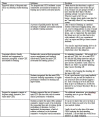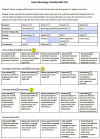Student Perceptions of Assessment for Workplace Learning and Summative Decisions Using Frequent Mini-CEXs
- PMID: 38406489
- PMCID: PMC10885268
- DOI: 10.15694/mep.2017.000113
Student Perceptions of Assessment for Workplace Learning and Summative Decisions Using Frequent Mini-CEXs
Abstract
This article was migrated. The article was marked as recommended. Introduction: Direct observation assessments that provide both formative feedback and data for summative decisions can be difficult to achieve. The mini-clinical evaluation exercise (mini-CEX) is a widely used tool of direct observation that provides opportunities for feedback. We introduced a direct observation system with frequent mini-CEXs to increase clerkship student learning opportunities and to improve competency-based summative decisions. However, students may express resistance to assessments for learning with any summative impact as they may perceive the assessments as purely a series of summative evaluations. Aims: We explored how frequent low-stakes mini-CEXs affect clerkship students' perception of learning and to understand student perceptions of these assessments supporting their end-of-rotation summative clinical performance evaluations. Methods: This qualitative study used a purposive sampling strategy of focus groups with students who completed multiple mini-CEXs during their four-week neurology clerkship at one of three sites. All eleven students chose to participate. Eight students completed eight mini-CEXs, two students completed seven, and one student completed four. Investigator triangulation was used with interpretation comparisons that included independent content analysis. The emerging themes were discussed and final theme consensus was reached. Results: Three major themes arose: perceived effects of frequent mini-CEXs for clerkship student learning by facilitating multiple opportunities for guided practice under low assessment anxiety; the importance of consistent, effective faculty feedback and engagement to maximize mini-CEXs for learning; and support for summative impact of frequent, mainly formative, low stakes mini-CEXs. Conclusions: Students perceived that frequent mini-CEXs are mainly formative assessments for learning while having summative impact. However, variable perceived faculty affinity and engagement with the mini-CEX are important considerations to maximize the assessments for learning. These findings support a shift towards workplace-based assessment programs for learning that promote frequent direct observation and feedback, while also improving the trustworthiness of summative decisions.
Keywords: assessment; feedback; mini-CEX; summative; workplace-based.
Copyright: © 2017 Mowchun JJ et al.
Similar articles
-
Implementation of the mini-CEX to evaluate medical students' clinical skills.Acad Med. 2002 Nov;77(11):1156-7. doi: 10.1097/00001888-200211000-00021. Acad Med. 2002. PMID: 12431932
-
Perceptions of purpose, value, and process of the mini-Clinical Evaluation Exercise in anesthesia training.Can J Anaesth. 2016 Dec;63(12):1345-1356. doi: 10.1007/s12630-016-0740-9. Epub 2016 Sep 23. Can J Anaesth. 2016. PMID: 27663452 English.
-
Implementation of a Mini-CEX Requirement Across All Third-Year Clerkships.Teach Learn Med. 2016 Oct-Dec;28(4):424-431. doi: 10.1080/10401334.2016.1165682. Epub 2016 May 4. Teach Learn Med. 2016. PMID: 27141826
-
Assessment in Undergraduate Competency-Based Medical Education: A Systematic Review.Cureus. 2024 Apr 11;16(4):e58073. doi: 10.7759/cureus.58073. eCollection 2024 Apr. Cureus. 2024. PMID: 38738047 Free PMC article. Review.
-
Assessment of clinical competence in competency-based education.Can J Dent Hyg. 2020 Jun 1;54(2):83-91. Can J Dent Hyg. 2020. PMID: 33240368 Free PMC article. Review.
References
-
- Alves de Lima A., Barrero C., Baratta S., Castillo Costa Y., Bortman G., Carabajales J., Van der Vleuten C.(2007). Validity, reliability, feasibility and satisfaction of the mini-clinical evaluation exercise (mini-CEX) for cardiology residency training. Medical Teacher. 29(8),785–790. 10.1080/01421590701352261 - DOI - PubMed
LinkOut - more resources
Full Text Sources



